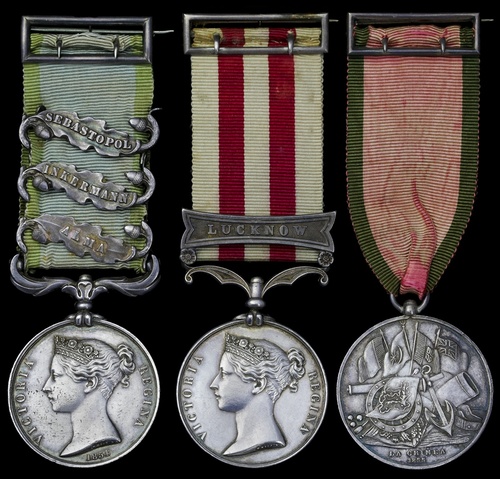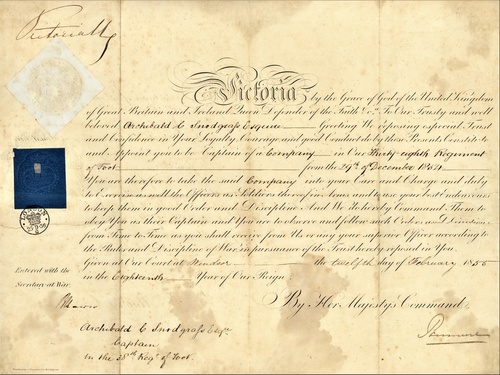Auction: 19001 - Orders, Decorations and Medals
Lot: 378
(x) An important group of three to Major Archibald Campbell Snodgrass, 39th, late 38th Foot, who served during the Crimean War as A.D.C. to his uncle Sir John Campbell; severely wounded in the first assault on the Redan on 18 June 1855, he went on to serve at the Siege and Capture of Lucknow.
Crimea 1854-56, 3 clasps, Alma, Inkermann, Sebastopol (Lieut. A. C. Snodgrass, A.D.C. to Sir John Campbell), officially engraved by Hunt & Roskell in large serif capitals; Indian Mutiny 1857-9, 1 clasp, Lucknow (Capt. A. C. Snodgrass, 38th Regt.); Turkish Crimea, Sardinian issue, privately manufactured by Hunt & Roskell, all mounted on original ribands and fitted with Hunt & Roskell silver top riband buckles, the first with light contact marks, otherwise good very fine (3)
[Order of the Medjidie] London Gazette 2 March 1858.
Archibald Campbell Snodgrass was born at Government House, Fredericton, New Brunswick in the spring of 1832. His father John James Snodgrass was Deputy Quartermaster General to the troops in Nova Scotia and its dependencies, while his mother was the daughter of General Sir Archibald Campbell, Bart., G.C.B. (1769-1843), who served with distinction at the Siege of Seringapatam and the Retreat to Corunna.
Snodgrass was gazetted as an Ensign to the 38th (1st Staffordshire) Regiment of Foot on 6 October 1848, advancing to Lieutenant on 7 November 1851. He served during the Crimean War as Aide de Camp to his uncle, Major-General Sir John Campbell, who commanded the 2nd Brigade of Sir Richard England's 3rd Division. He landed with the army at Eupatoria on 14 September 1854, and was present at the Battles of Alma and Inkermann. He appears in a photograph by Roger Fenton, the famous Crimean War photographer, taken in the camp before Sebastopol. Next to him can be seen Captain Hume, Campbell's other A.D.C. (see next Lot).
Promoted to Captain on 29 December 1854, Snodgrass was severely wounded in the first attack on the Redan, a key Russian strongpoint guarding Sebastopol. The assault was planned for 18 June 1855, the Anniversary of Waterloo. That morning his uncle, with 'a courage amounting to rashness,' volunteered to lead the forlorn hope. He rushed out of the trenches and fell instantly while cheering his men, his head taken off with the same shot that killed Colonel Yea of the 7th Fusiliers. Snodgrass was wounded just moments later. The infantry suffered appallingly, with nearly 1,500 casualties, and the attack failed. Snodgrass oversaw his uncle's burial on Cathcart Hill, near Inkermann.
His award of the Order of the Medjidie, 5th Class was announced in the London Gazette on 2 March 1858. He also received the 5th Class of the Legion of Honour and the Sardinian Medal for Valour. Snodgrass then served with the 38th Foot in India, carrying the rank of Brevet Major. He took part in the Siege and Capture of Lucknow. He exchanged to the 39th (Dorsetshire) Regiment of Foot on 1 April 1859, and retired from the Army on 17 November 1863, with the rank of Brevet Lieutenant-Colonel. He died just days later at Millbank, Southampton; sold with Snodgrass's Commission Certificate of 29 December 1854, signed by Lord Panmure, together with confirmation of medal entitlement and a folder of research.
Recommended reading:
Hope, R., A Staffordshire Regiment in the Crimea: 38th Regiment of Foot (Leek, 2013).
Subject to 5% tax on Hammer Price in addition to 20% VAT on Buyer’s Premium. For more information please view Terms and Conditions for Buyers.
Sold for
£2,800







